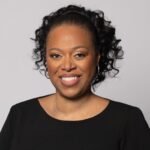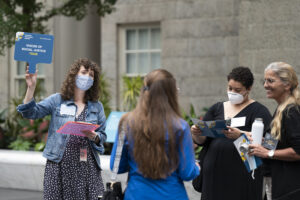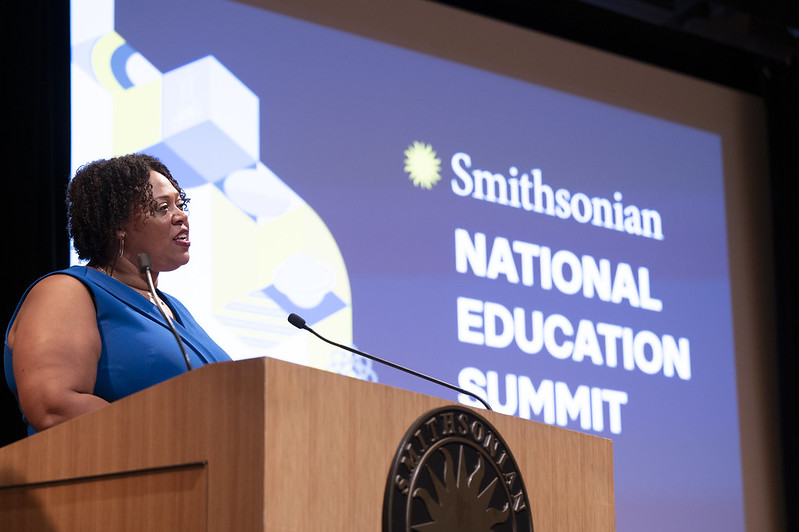In the coming months, educators from the Smithsonian Institution will write for SmartBrief, sharing details on some of their free resources and the ways teachers have used them. But first, we want to introduce you to Monique Chism, the Smithsonian’s undersecretary for education. She explains the Smithsonian educators’ mission, and she details an upcoming free summit for teachers. — SmartBrief Education Editors

In 2016, a partnership of leaders and organizations came together to create what became the Science of Learning and Development, or SoLD, Alliance with the goal of exploring a shared hypothesis that applying the science of learning and development as a critical driver of equity and excellence can transform education systems. The key takeaway from the research is that all children can learn and thrive given the right conditions.
The SoLD Alliance describes five components that are essential for young people to learn, develop and thrive, including:
- Positive developmental relationships.
- Environments filled with safety and belonging.
- Rich learning experiences.
- Development of critical skills, mindsets and habits.
- Integrated support systems.
Smithsonian educators embrace these essentials
Educators at the Smithsonian Institution are committed to ensuring that all learners experience rich and engaging learning environments. Through the exploration of holistic and inclusive stories, our educators offer tools, resources and programs that help cultivate a sense of belonging and representation.
The Smithsonian is one of the nation’s — and the world’s — most dynamic resources to support and enhance learning development. Our 21 museums, three cultural centers, 21 libraries and archives, six research centers, six education centers and National Zoo encompass every part of the human experience — art, history, culture, science. They make connections between artistic expression and scientific discovery, future innovations and historic research, individuals and communities.
For decades, Smithsonian educators have worked alongside teachers and students in classrooms in all 50 states and the US territories, in museums and research centers, and online. We see and understand the challenges facing the profession today as teachers strive to provide the best possible learning experiences for their students. With our varied collections and experienced professionals, the Smithsonian is well-positioned to support educators with information, professional learning and engaged experiences both in and out of the classroom.
One example is Smithsonian Summer Sessions, which are online courses that focus on teaching with museum objects, interrogating the stories we tell and inspiring civic engagement. Educators from six Smithsonian museums explore interdisciplinary connections among their collections and model teaching strategies that participants can implement with their students, whether online or in the classroom.

Inclusive and culturally responsive teaching
We recognize that educators are powerful change agents. Their work contributes to students thriving across all domains of life, including personal, academic, social and civic. The newly named 2023 National Teacher of the Year, Rebecka Peterson, believes every teacher can turn a bad day into a good day. Education scholars Jeannie Oakes, Martin Lipton, Lauren Anderson and Jamy Stillman describe what they term “Teaching to Change the World.” It’s an approach grounded in the idea that a hopeful, democratic future depends on teachers supporting all students and addressing inequalities associated with race, social class, language and gender.
Smithsonian educators approach research, scholarship, and professional standards in ways that ensure that learning experiences expand opportunities for inquiry and understanding from a holistic and inclusive posture that offers a diverse representation of our shared experiences.
A summit to foster belonging
We are committed to engaging with preK-12 educators in professional learning that enables them to activate students’ strengths, prior knowledge and assets. We understand that as a trusted source, we have a responsibility to the public to be fair, accurate and unbiased.
One of my favorite things is bringing educators to the Smithsonian and spending time with them. The Smithsonian will host its third, free National Education Summit, “Together We Thrive; Cultivating a Sense of Belonging,” July 18-20 in Washington, D.C.. While the summit comes at a time of uncertainty and challenge in our nation, it also comes at a time of great hope and imagination to rethink all that is possible in education and the shared future we hope to inspire and make a reality.
Featured keynote speakers include award-winning actor, author and anti-bullying activist Maulik Pancholy; the 2023 Council of Chief State School Officers’ National Teacher of the Year Rebecka Peterson; education researcher and thought leader Pamela Cantor; education advocate Ed Magee of the Fender Play Foundation; and our own Smithsonian leader, Secretary Lonnie Bunch III.
Sessions from more than 300 talented Smithsonian educators will explore relevant themes at the intersections of art, culture, history and science. We will also feature sessions from leading education and innovation collaborators, such as the Ford’s Theatre, the Library of Congress, and the National Science Teaching Association.
Finally, we will be joined by a panel of students, who will share their own personal learning journeys, discuss their experiences with Smithsonian programs in which they have participated and provide insights into the types of intentionally designed learning environments that can foster empowering, culturally affirming, transformative and personalized experiences.
This year’s Summit holds the promise that thousands of educators will gather together and have meaningful and important conversations that will inspire them for the school year ahead.
Monique Chism, Ph.D., is the Smithsonian’s undersecretary for education and is responsible for defining the Institution’s educational priorities. She oversees the Smithsonian’s collective initiatives, communication strategies and funding for programs that benefit learners of all ages.
Opinions expressed by SmartBrief contributors are their own.
_________________________
Subscribe to SmartBrief’s FREE email newsletter to see the latest hot topics on EdTech. It’s among SmartBrief’s more than 250 industry-focused newsletters.
